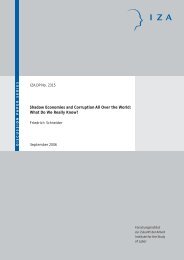The Great Recession of 2008-2009: Causes ... - Index of - IZA
The Great Recession of 2008-2009: Causes ... - Index of - IZA
The Great Recession of 2008-2009: Causes ... - Index of - IZA
- TAGS
- recession
- index
- ftp.iza.org
You also want an ePaper? Increase the reach of your titles
YUMPU automatically turns print PDFs into web optimized ePapers that Google loves.
close to restoring full employment.<br />
<strong>The</strong>re are several likely explanations for the modest outcome. One possibility is that the US administration’s<br />
initial forecasts about the depth and duration <strong>of</strong> the recession, and its expected impact on the labour market,<br />
were rather optimistic. This perhaps influenced the size <strong>of</strong> the fiscal policy response and made it less ambitious<br />
than it otherwise would have been. One ‘back-<strong>of</strong>-the envelope’ calculation (Baker <strong>2009</strong>) suggests that the<br />
current employment and output gap can only be bridged by a fiscal stimulus package that is more than three<br />
times larger than ARRA. Some leading economists (example Paul Krugman and Laura Tyson) have lent their<br />
voices to calls for a new round <strong>of</strong> fiscal stimulus. It also appears that the rate <strong>of</strong> disbursing the allocated monies<br />
to various projects have been quite slow. So far, only about 30 per cent <strong>of</strong> the committed funds for <strong>2009</strong> have<br />
been spent. Even by 2010, 75 per cent <strong>of</strong> ARRA funds are scheduled to be utilized. Concerns have been raised<br />
about the current composition <strong>of</strong> ARRA. One study (Zandi <strong>2009</strong>) shows that the mean values <strong>of</strong> fiscal<br />
multipliers range between 0.30 and 0.49 for (permanent) tax cuts, but they are substantially higher for<br />
government purchases and transfers (between 1.38 and 1.73). Hence, one can justify the claim that the<br />
‘…government could have achieved …more at the same cost by skewing the stimulus package towards outlays<br />
rather than tax cuts’ (Levy Institute <strong>2009</strong>).<br />
Source: Andrews (<strong>2009</strong>); Baker (<strong>2009</strong>); Burtless (<strong>2009</strong>); Congressional Budget Office (CBO) (<strong>2009</strong>); Council<br />
<strong>of</strong> Economic Advisers (CEA) (<strong>2009</strong>; Romer (<strong>2009</strong>); ‘Recovery.gov, ‘Timeline’, July 20; Zacharias et al. (<strong>2009</strong>);<br />
Romer and Bernstein (<strong>2009</strong>); Zandi (<strong>2009</strong>); Bivens (<strong>2009</strong>; and Shierholz (2010).<br />
Box 3: <strong>The</strong> Indonesian fiscal stimulus package: an assessment<br />
Official projections suggest that the global economic crisis will reduce the Indonesian economic growth rate to<br />
4.0 – 4.7 per cent in <strong>2009</strong> from a pre-crisis growth rate that reached above 6 per cent per annum in 2007 and<br />
<strong>2008</strong>. <strong>The</strong> Indonesian government has responded to the projected growth slowdown with a combination <strong>of</strong><br />
financial, monetary and fiscal policies. A fiscal stimulus package has been enacted (with effect from 1 March,<br />
<strong>2009</strong>) amounting to 1.4 per cent <strong>of</strong> GDP.<br />
Tax cuts represent approximately 79 per cent <strong>of</strong> the overall fiscal package <strong>of</strong> Rp 73.3 trillion. <strong>The</strong>y consist <strong>of</strong><br />
reductions in both indirect taxes and income taxes. <strong>The</strong> balance is directed towards infrastructure expenditure<br />
(Rp 12.2 trillion) and direct subsidies (Rp 4.8 trillion). Thus, a modest amount has been allocated towards<br />
enhancing job-creating public expenditure. It is widely acknowledged that tax cuts are not as effective as jobcreating<br />
public expenditure or a scaled up social protection system in dealing with the consequences <strong>of</strong> a<br />
systemic global economic downturn.<br />
An <strong>of</strong>ficial estimate claims that 93 per cent <strong>of</strong> the earmarked expenditure was accomplished by end-<strong>2009</strong> and<br />
that an estimated 1 million short-term jobs were created. A ‘simulation’ exercise was also undertaken by the<br />
Indonesian government to work out how the unemployment rate will behave with expansionary fiscal policy and<br />
without it. <strong>The</strong> exercise that was undertaken demonstrated that fiscal expansion along the lines described here<br />
would contain the rise in the unemployment rate to 8.3 per cent in <strong>2009</strong>. In the absence <strong>of</strong> the fiscal<br />
interventions, the ‘simulation’ exercise shows that unemployment will rise to 8.9 per cent. Had the pre-crisis<br />
growth rates prevailed, the aggregate unemployment rate would have declined to 7.4 per cent. <strong>The</strong>se estimates<br />
suggest that the impact <strong>of</strong> the fiscal stimulus package is modest.<br />
Source: Ministry <strong>of</strong> Finance (<strong>2009</strong>); Soesastro (<strong>2009</strong>); Islam and Chowdhury (<strong>2009</strong>).<br />
<strong>The</strong> policy message embedded in Table 5 is that governments enacting fiscal stimulus<br />
packages should concentrate on spending measures rather than tax cuts. Furthermore, within<br />
the category <strong>of</strong> spending measures, governments should focus on capital expenditure, such as<br />
investments in employment-intensive infrastructure. This will yield higher dividends in terms<br />
39
















